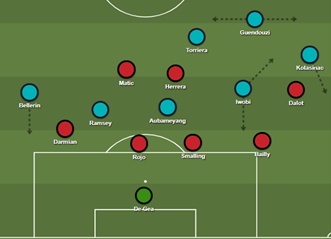(Grafiken: Erstellt von Cavanis Friseur / © Footyrenders)
Manchester United has reached its point of saturation under Jose Mourinho, and Wednesday’s encounter with Unai Emery’s in-form Arsenal was a bigger test to face than that previously endured in a 2-2 draw with Southampton.
United started the match with a return to a 3-4-1-2 formation, with Jesse Lingard as the attacking midfielder playing off of a strike duo of Marcus Rashford and Anthony Martial. With Paul Pogba on the bench, United also deployed a rigid approach in midfield with a double pivot of Ander Herrera and Nemanja Matic.
It can be argued that Mourinho went with a back three against Arsenal to match Arsenal’s front line, and to allow for control of United’s half.
Arsenal maintained a back three system which has been used in recent games, with Aaron Ramsey and Alex Iwobi as inside-forwards. Matteo Guendouzi started in place of the unavailable Granit Xhaka in midfield alongside the tenacious Lucas Torreira.
Coming into this game on the back off of a fantastic 4-2 North London derby win against Tottenham Hotspur, Arsenal looked the more favourable bet in a game which was very enthralling and interesting from a tactical perspective.
Arsenal dominate the left-side with wing-backs pushing high up the pitch
Arsenal gradually grew into the game after United had a dominant start, keeping tight to Arsenal’s midfield in their half, restricting build-up through the centre in the process.

Arsenal attacked primarily through the left-side, with wing-back Sead Kolasinac constantly overlapping as Alex Iwobi drifted inside. Although Iwobi ventured in and out of the game, he was intent on making runs in between the United wing-back and centre-back within the opening minutes of the match which gave United problems.
The movement of Kolasinac and Iwobi – particularly the former made advantage of the exposed space left by the poor positioning of wing-back Diago Dalot.
Guendouzi is key
The contrast in how the right and left-sides attack for Arsenal is interesting, and in this match, the left-side was less flexible in its movement. Hector Bellerin, unlike Kolasinac, would drift further inside to make underlapping runs into the box for a different option.
Although, opposing wing-back Matteo Darmian did well to track the runs of Bellerin on more than one occasion. I think had Granit Xhaka started the match, there would have been less of a lopsidedness to Arsenal’s attack, in that in contrast with Matteo Guendouzi, Xhaka would have been more likely to release longer diagonal passes from deeper positions.
Nevertheless, Guendouzi was also key to how Arsenal built-up play and attacked on the left-side.

United’s man-marking approach aimed to restrict Arsenal’s build-up
As Mourinho has done in many of the “big games” during his time with United, he deployed a man-marking tactic. This man-marking tactic oversaw United’s Ander Herrera (centre-midfield), and Jesse Lingard (no.10) mark Matteo Guendouzi and Lucas Torreira respectively. The latter case is reminiscent of both Juan Mata and Dele Alli was unconventionally tasked with marking Jorginho against Chelsea.
Lingard was also a nuisance for Arsenal in how he moved about the spaces between Arsenal’s midfield and defence, looking to receive the ball between the lines, which simply made Lingard quite difficult to mark. United’s man-marking approach did not coincide well with United’s decision not to press in the opposition, which was arguably one of the reasons as to how Arsenal got into the game.
In addition, although synonymous with rivals Manchester City, United were prone to making a few tactical fouls against Arsenal. Both Herrera and Lingard were booked for fouls in order to slow the game down. After a wayward pass from Herrera, Matic brought down an Arsenal player, which restricted Arsenal’s opportunity to counter-attack.
I do think that other than this instance, Herrera was one of United’s better players on the pitch; covered ground well, and supported the defence in deeper positions during the latter stages of the match, too.
Arsenal in possession
Arsenal dominated possession, but less so than I would have thought prior to the match. United’s lack of willingness to press meant that Arsenal had more freedom to build from the back, particularly during the first-half.
Guendouzi, positioned on the left-side of Arsenal’s pivot, was always looking to receive the ball across the centre in front of the defence and as he drifted towards the flank. Guendouzi may lack the range of passes possessed by Xhaka, but I like Guendouzi’s risk taking in receiving the ball in deep areas and carry from then on.

Arsenal’s extra numbers in midfield were also beneficial in creating opportunities. In situation during the second-half (69 minutes), centre-forward Pierre-Emerick Aubameyang dropped into a slightly deeper position on the cusp of United’s penalty-area with Bellerin running ahead.

This interplay on the edge of United’s goal was one way in which Arsenal aimed to break down United’s rigid defence and supports the earlier point of Arsenal’s right-side being that more flexible than the left.
But, irrespective of the domination of the ball, especially in and around the box, Arsenal missed no.10 Mesut Özil in these types of situations. Perhaps when Özil returns to the first XI, could Arsenal adapt to playing a 3-4-1-2 themselves, in order to accommodate the link-up presence they sorely missed against United?
First-half goals
Both of the sides opening goals were partially at fault of goalkeeping mistakes. Lucas Torreira’s inswinging corner was headed by right-sided centre-back Shkodran Mustafi before being parried by David de Gea into the air before the ball fell into the goal.
A Marcos Rojo free-kick was saved well by Bernd Leno, but Herrera retrieved the ball and passes across goal, whereas Leno failed to get back into a good position as Anthony Martial placed the ball into the goal. Both teams sets of goals came one after the other very quickly.
Second-half tactical changes
Aaron Ramsey was replaced by Henrikh Mkhitaryan, who may have been the better option going into this match. Both sides seemingly became more intent on attacking against each other through quick transitions, with United playing longer passes into advance positions as Arsenal try to re-organise their defence, and Arsenal pressing/countering.
The main change from Arsenal during the second-half, was the addition of Alexandre Lacazette. Replacing Iwobi, Lacazette moved into a central position, with Aubameyang slighlty to his left. Arsenal could have easily played two up front, but wanted to maintain the overload on the left-side. And with Mkhitaryan and Lacazette, Arsenal’s pressing of United’s midfield and defence paid off.
Pressing Marcos Rojo, Lacazette regained the ball in United’s half, before playing a one-two with Mkhitaryan which led Lacazette into the box, before the ball fumbled, presumably off of Marcos Rojo (did the ball touch Lacazette’s shin last?), into the goal.
This gave Arsenal the lead on the 68th minute, but almost straight afterwards, United once again scored. A long pass met substitute Romelu Lukaku who held up play as the Arsenal defence aimed to reorganise, before Jesse Lingard pounced onto the ball and knocked it away.
Both goals in the second-half came from different sets of transitional play, and defensive mislaps.
United eventually brought on Paul Pogba, but the midfielder had little time to truly impact the game. United’s build-up in this game was lacking, presumably due to the lack of a creative force in midfield, why did Fred not feature? A better carrier than Herrera and Matic, and as if not more mobile, Fred would have been able to carry out the role of Herrera and Herrera would have been able to serve Matic’s role.
Conclusion
A draw was a fair result, considering how both sides executed their game plans. Arsenal were the better side in terms of breaking down the opposition, and credit must be given to Unai Emery, who’s ideas are becoming more prevalent within this Arsenal side over time, but, will Arsenal eventually be caught out?
Written by Ryan Quinn. Make sure you follow him on Twitter (@Quinntactics) and read his blog for other great articles.





